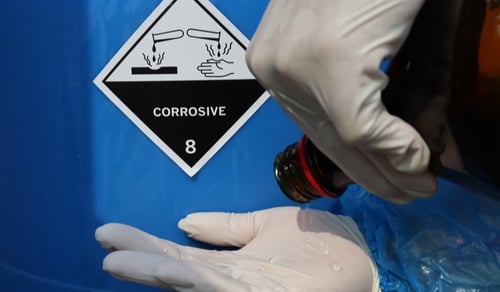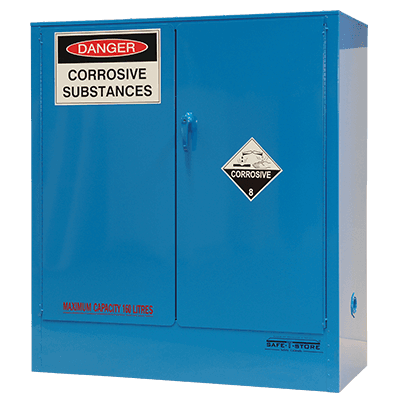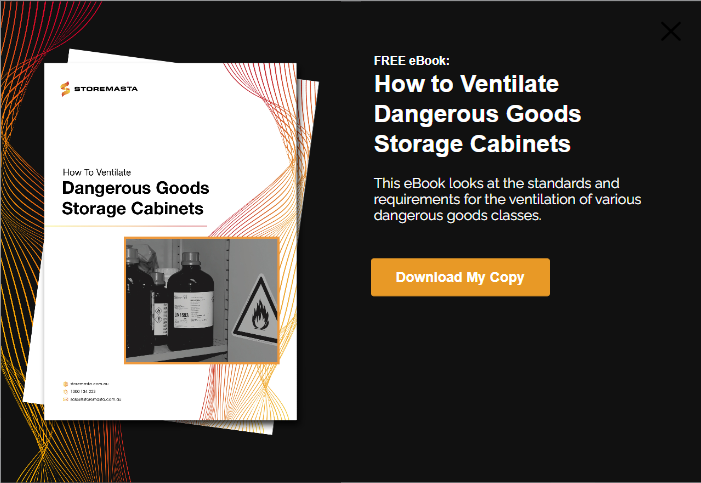If your organisation uses corrosive substances such as hydrochloric acid, sulfuric acid, sodium hydroxide or potassium hydroxide, it’s very important that you store and handle these dangerous substances in a way that minimises the risks that they pose. Corrosive substances are very hazardous to people, property and the environment due to their ability to quickly dissolve materials through complex chemical processes. Corrosive substances also release hazardous vapours that are can damage human health and attack metal, stone and other materials.
To mitigate the risk of exposure to corrosive vapours, it’s crucial that you consider the ventilation of corrosive chemical storage cabinets. However, before we dive into the ventilation requirements for alkali and acid cabinets , let’s look at corrosive substances — and how corrosive storage cabinets control the risks.
Corrosive Substances
The Australian Dangerous Goods Code defines corrosive substances as:
Class 8 corrosive substances are substances which, by chemical action, will cause severe damage when in contact with living tissue, or, in the case of leakage, will materially damage, or even destroy, other goods or the means of transport.
Due to the chemical and physical properties of these substances, contact with corrosive substances – as well as their vapours – must be tightly controlled to maintain safety and compliance in the working environment.

Corrosive chemical spills and vapours can cause damage to people, property and the environment.
Hazards and Risks
With the unique ability to corrode and destroy a range of materials – from metal to human tissue – Class 8 Corrosive Substances require the most careful handling and storage practices to reduce risk.
Some key hazards and risks associated with the use of corrosive chemicals in the workplace include:
- Damage to property including vehicles, buildings, equipment and tools
- Human harm through contact with the skin or eyes, or inhalation of corrosive fumes
- Environmental damage in the event of an accidental release
- Contamination of soil and waterways if spilled into the environment
What is a Corrosive Storage Cabinet?
A corrosive storage cabinet is a chemical storage cabinet that is specifically designed and manufactured for the safe storage of Class 8 Corrosives. To be deemed as compliant, these cabinets must meet the construction and maintenance requirements of the Australian Standard AS 3780:2008 - The storage and handling of corrosive substances.
Features of a compliant corrosive storage cabinet include liquid-tight spill containment sumps, self-closing and close fitting doors, spill protection for shelving (metal cabinets) and the applicable dangerous goods label and hazard signage.
Metal or Poly Cabinets?
Corrosive storage cabinets can be constructed from metal or polyethylene, depending on the pH level of the corrosive chemicals.
Generally speaking, metal (usually double-walled steel) corrosive storage cabinets are suitable for the storage of corrosive chemicals with a pH level that is closest to neutral. While there are spill trays within the cabinet to prevent corrosion in the event of spills, these corrosives (such as hypochlorous acid) don’t require corrosion protection to the degree that other Class 8 chemicals do.
Polyethylene (poly) storage cabinets, however, are made from high grade polyethylene – which prevents corrosive vapours from attacking the storage cabinet. Chemicals that are best suited to storage in poly cabinets include strong acids (such as sulphuric acid) and alkalis (including potassium hydroxide).
Ventilation Requirements for Class 8 Chemical Storage Cabinets
Are you searching for an answer to ‘do acid cabinets need to be vented?’ Or are you wondering if your corrosive storage cabinet needs a mechanical ventilation system. To determine your need for ventilation with your Class 8 storage cabinet, you must refer to a range of requirements and regulations, as well as conduct your own risk assessment.
Corrosive Base and Acid Cabinet Ventilation Requirements
When we look at the requirements for ventilation for dangerous goods storage cabinets, the most reliable and comprehensive resource is the applicable Australian Standard.
The Australian Standard that sets out the ventilation requirements for corrosive storage cabinets is AS 3780:2008 - The storage and handling of corrosive substances.
Section 6.2.4 of this Standard states:
Wherever people are in an area where the corrosive substances are kept, adequate ventilation shall be provided. In addition, where the corrosive substance presents an inhalation hazard (of dust, mists, fumes or vapours) and packages are opened, routine air monitoring shall be conducted to determine the level of airborne contamination. Where there is a significant level of airborne contamination, appropriate control strategies shall be implemented.
NOTE: Workplace exposure standards also apply.
As this Standard doesn’t state the ventilation system “shall” be installed on a Class 8 chemical storage cabinet, it means that it isn’t a mandatory requirement.
However, it does state that “wherever people are in an area where the corrosive substances are kept, adequate ventilation shall be provided”. Therefore, if people work in the area where your corrosive substances are stored, it’s very important that you install a compliant ventilation system on your storage cabinets to keep the concentration of the corrosive vapours at a safe limit.
Section 6.2.4 also explains that workplace exposure standards apply. Therefore, if the concentration of corrosive vapours within the chemical storage cabinet exceeds the workplace exposure standard, a ventilation system must also be installed.
This mechanical ventilation system will keep the concentration of the corrosive vapours below the maximum limit specified in the workplace exposure standards.
Considering the Workplace Exposure Standards
Exposure to any kind of hazardous substances will pose significant health risk upon your workers.
Some of these health risks include:
- Asphyxiation
- Vomiting
- Nausea
- Headaches
- Irritation to the eyes, ears and throat
- Dizziness
To help combat these health risks, Safe Work Australia developed the workplace exposure standards. These exposure standards identify hundreds of hazardous substances and their legal airborne concentration limits.
If the corrosive substances stored inside a corrosive storage cabinet are listed in the workplace exposure standards — and the concentration of the vapours exceed the limit outlined in the standards — the corrosive storage cabinet will require ventilation.
REMEMBER: Whenever you’re storing dangerous goods or hazardous chemicals in the workplace, a comprehensive risk assessment is necessary to determine all possible risks.
Features of a Compliant Ventilation System for Corrosive Substances
If you determine that your corrosive storage cabinets require a ventilation system, it’s important to install a ventilation system that will not pose any further risks to the people in your organisation.
A safe ventilation system for corrosive storage cabinets must follow the requirements outlined below:
- A mechanical ventilation system should be designed so that it prevents any vapours from escaping into the room.
- The ventilation system shall be vented to the outside atmosphere in a location that is safe to disperse corrosive vapours. A safe location will be away from places where people congregate.
- The air inlet shall be attached to the vent port at the top of the cabinet and the corrosive vapours shall be extracted from the bottom vent port via the exhaust fan. This configuration is most effective as most corrosive vapours are heavier than air and reside in the bottom of the cabinet.
- A ventilation system cannot be linked to multiple chemical cabinets. A ventilation system connected to multiple cabinets could cause vapours from incompatible dangerous goods to mix, resulting in violent chemical reactions.
- When a mechanical ventilation system is not attached to a cabinet, the vent bungs must be tightly screwed into the vent ports. This stops any corrosive vapours from escaping into the workplace.
- In all instances the ventilation system shall not compromise the structural integrity of the cabinet.
- In all cases, the ventilation duct shall not be smaller than the size of the venting opening on the side of the cabinet. A ventilation system shall be designed by an appropriately qualified engineer. The system must comply with AS/NZS 1668.2:2002
- The exhaust fan used to extract corrosive vapours from the cabinet must be corrosive resistant. This includes corrosive resistant blades and shrouds.
- The ventilation duct must be made from corrosive resistant material. Steel or galvanised pipes aren’t a good option as these materials are susceptible to corrosion. PVC piping is an excellent option as it is resistant to corrosion and easy to install.
- In all cases the diameter of the ducting should be no smaller than the vent opening on the cabinet.
Venting Alkali and Acid Cabinets
As corrosive vapours pose severe health hazards upon the people and property of your organisation, it's good practice to ventilate corrosive storage cabinets so that the concentration of corrosive vapours is controlled to a safe working limit. For a ventilation system to be compliant, it must follow the requirements outlined in AS 3780:2008.
If you’re looking for further information on how to ventilate dangerous goods storage cabinets, including those that store corrosives, flammable liquids and oxidising agents, why not access our free eBook by simply clicking on the image below?
Joining the team as a Dangerous Goods Storage Consultant, Melissa Hampton became Storemasta's Marketing Manager in late 2021. With extensive knowledge and experience in chemical compliance, Melissa is responsible for leading the Marketing team and helping shape their marketing strategy. In her spare time, you can find Melissa hiking, swimming and enjoying the great outdoors in beautiful north-west Tasmania.

